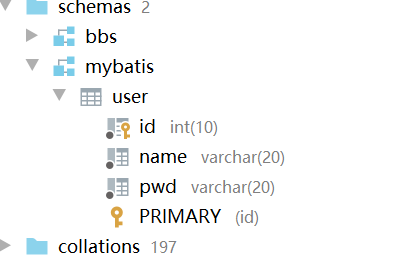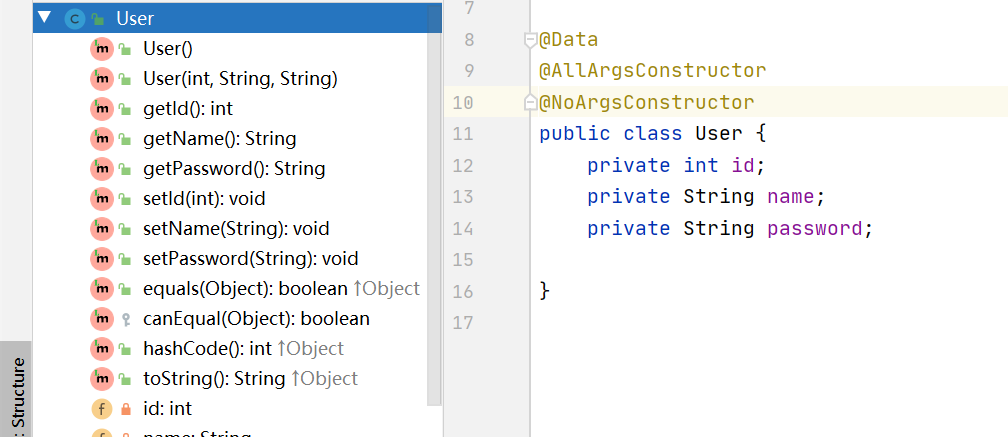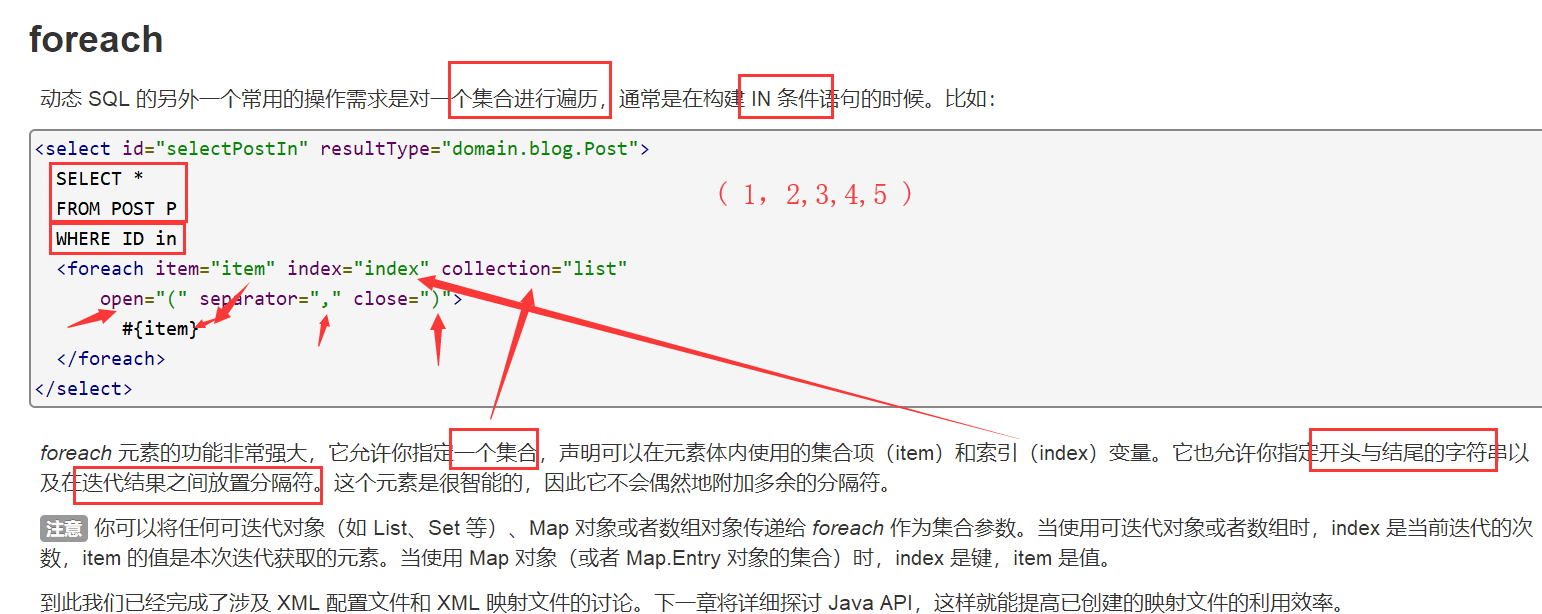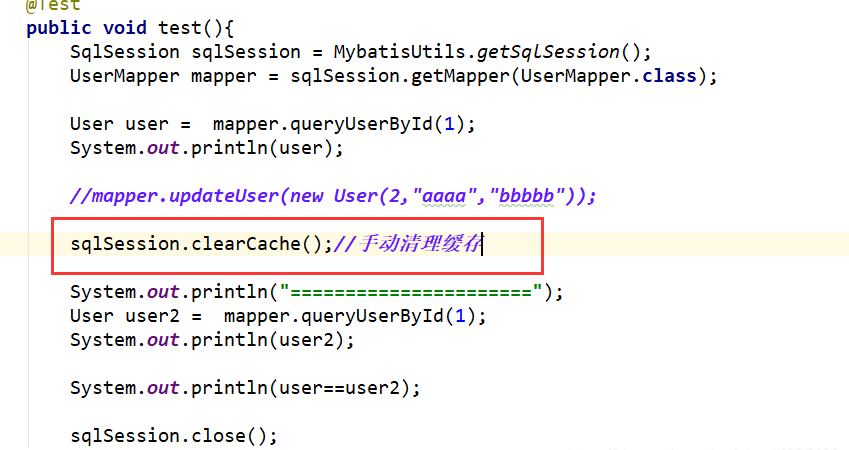【狂神说JAVA】MyBatis笔记(所有代码均经过测试)
所有代码均经过测试
1、简介
1.1 什么是Mybatis

- MyBatis 是一款优秀的持久层框架;
- 它支持自定义 SQL、存储过程以及高级映射。MyBatis 免除了几乎所有的 JDBC 代码以及设置参数和获取结果集的工作。MyBatis 可以通过简单的 XML 或注解来配置和映射原始类型、接口和 Java POJO(Plain Old Java Objects,普通老式 Java 对象)为数据库中的记录。
1.2 持久化
数据持久化
- 持久化就是将程序的数据在持久状态和瞬时状态转化的过程
- 内存:断电即失
- 数据库(Jdbc),io文件持久化。
为什么要持久化?
- 有一些对象,不能让他丢掉
- 内存太贵
1.3 持久层
Dao层、Service层、Controller层
- 完成持久化工作的代码块
- 层界限十分明显
1.4 为什么需要MyBatis
- 帮助程序员将数据存入到数据库中
- 方便
- 传统的JDBC代码太复杂了,简化,框架,自动化
- 不用MyBatis也可以,技术没有高低之分
- 优点:
- 简单易学
- 灵活
- sql和代码的分离,提高了可维护性。
- 提供映射标签,支持对象与数据库的orm字段关系映射
- 提供对象关系映射标签,支持对象关系组建维护
- 提供xml标签,支持编写动态sql
2、第一个Mybatis程序
思路:搭建环境 --> 导入MyBatis --> 编写代码 --> 测试
2.1 搭建环境
新建项目
-
创建一个普通的maven项目
-
删除src目录 (就可以把此工程当做父工程了,然后创建子工程)
-
导入maven依赖
<!--导入依赖--> <dependencies> <!--mysqlq驱动--> <dependency> <groupId>mysql</groupId> <artifactId>mysql-connector-java</artifactId> <version>8.0.22</version> </dependency> <!--mybatis--> <dependency> <groupId>org.mybatis</groupId> <artifactId>mybatis</artifactId> <version>3.5.4</version> </dependency> <!--junit--> <dependency> <groupId>junit</groupId> <artifactId>junit</artifactId> <version>4.12</version> <scope>test</scope> </dependency> </dependencies> -
创建一个Module
2.2 创建一个模块
编写mybatis的核心配置文件
<?xml version="1.0" encoding="UTF-8" ?>
<!DOCTYPE configuration
PUBLIC "-//mybatis.org//DTD Config 3.0//EN"
"http://mybatis.org/dtd/mybatis-3-config.dtd">
<!--configuration核心配置文件-->
<configuration>
<environments default="development">
<environment id="development">
<transactionManager type="JDBC"/>
<dataSource type="POOLED">
<property name="driver" value="com.mysql.jdbc.Driver"/>
<property name="url" value="jdbc:mysql://localhost:3306/mybatis?userSSL=true&useUnicode=true&characterEncoding=UTF-8&serverTimezone=UTC"/>
<property name="username" value="root"/>
<property name="password" value="123456"/>
</dataSource>
</environment>
</environments>
</configuration>
编写mybatis工具类
public class MybatisUtils {
static SqlSessionFactory sqlSessionFactory = null;
static {
try {
//使用Mybatis第一步 :获取sqlSessionFactory对象
String resource = "mybatis-config.xml";
InputStream inputStream = Resources.getResourceAsStream(resource);
sqlSessionFactory = new SqlSessionFactoryBuilder().build(inputStream);
} catch (IOException e) {
e.printStackTrace();
}
}
//既然有了 SqlSessionFactory,顾名思义,我们可以从中获得 SqlSession 的实例.
// SqlSession 提供了在数据库执行 SQL 命令所需的所有方法。
public static SqlSession getSqlSession(){
//SqlSession sqlSession = sqlSessionFactory.openSession();
//return sqlSession;
return sqlSessionFactory.openSession();
}
}
2.3测试
2.3.1注意点
错误:org.apache.ibatis.binding.BindingException: Type interface com.Sun.Dao.UserDao is not known to the MapperRegistry.
< !--每一个Mapper.xml都需要Mybatis核心配置文件中注册!-->
<mappers>
<mapper resource="com/Sun/Dao/UserMapper.xml"></mapper>
</mappers>
2.3.2约定大于配置
<!--在build中配置resources,来防止我们资源导出失败的问题-->
<build>
<resources>
<resource>
<directory>src/main/resources</directory>
<includes>
<include>**/*.properties</include>
<include>**/*.xml</include>
</includes>
<filtering>true</filtering>
</resource>
<resource>
<directory>src/main/java</directory>
<includes>
<include>**/*.properties</include>
<include>**/*.xml</include>
</includes>
<filtering>true</filtering>
</resource>
</resources>
</build>
能会遇到的问题:
- 配置文件没有注册
- 绑定接口错误
- 方法名不对
- 返回类型不对
- Maven导出资源问题
3、CURD
3.1、namespace
namespace中的包名要和Dao/Mapper接口的包名一致
3.2. select
选择,查询语句;
-
id:就是对应的namespace中的方法名;
-
resultType : Sql语句执行的返回值;
-
parameterType : 参数类型;
编写接口
public interface UserMapper {
List<User> getAllUser();
User getUserByID(int id);
}
编写对应的mapper中的sql语句
<select id="getAllUser" resultType="com.Sun.pojo.User">
select * from mybatis.user
</select>
测试
@Test
public void addUser(){
SqlSession sqlSession = MybatisUtils.getSqlSession();
UserMapper mapper = sqlSession.getMapper(UserMapper.class);
int number = mapper.addUser(new User(6, "小明", "234567"));
if(number>0){
System.out.println("插入成功");
}
sqlSession.commit();
sqlSession.close();
}
3.3.注意:增删改查一定要提交事务:
sqlSession.commit();
3.4. Insert
<insert id="addUser" parameterType="com.Sun.pojo.User">
insert into mybatis.user(id,name,pwd) values (#{id},#{name},#{pwd});
</insert>
3.5. update
<update id="updateUser" parameterType="com.Sun.pojo.User">
update mybatis.user set name=#{name},pwd=#{pwd} where id=#{id} ;
</update>
3.6. Delete
<delete id="deleteUser" parameterType="int">
delete from mybatis.user where id=#{id}
</delete>
3.7.分析错误
标签不要匹配错
resource绑定mapper,需要使用路径!
程序配置文件必须符合规范!
NullPointerException,没有注册到资源!
输出的xml文件中存在中文乱码问题!
maven资源没有导出问题!
3.8.万能Map
假设,我们的实体类,或者数据库中的表,字段或者参数过多,我们应该考虑使用Map
UserMapper接口
int addUser2(Map<String,Object>map);
UserMapper.xml
<insert id="addUser2" parameterType="com.Sun.pojo.User">
insert into mybatis.user (id,name,pwd) values (#{userid},#{username},#{userpassword})
</insert>
测试
@Test
public void addUser2(){
SqlSession sqlSession = MybatisUtils.getSqlSession();
UserMapper mapper = sqlSession.getMapper(UserMapper.class);
HashMap<String, Object> map = new HashMap<>();
map.put("userid",7);
map.put("username","小李");
map.put("userpassword","12345678");
int number = mapper.addUser2(map);
if(number>0){
System.out.println("插入成功");
}
sqlSession.commit();
sqlSession.close();
}
Map传递参数,直接在sql中取出key即可! 【parameter=“map”】
对象传递参数,直接在sql中取出对象的属性即可! 【parameter=“Object”】
只有一个基本类型参数的情况下,可以直接在sql中取到
多个参数用Map , 或者注解!
3.9.模糊查询
模糊查询这么写?
-
Java代码执行的时候,传递通配符% %
List<User> userByName = mapper.getUserByName("%程%"); -
在sql拼接中使用通配符
<select id="getUserByName" resultType="com.Sun.pojo.User"> select *from mybatis.user where name like "%"#{value}"%"; </select>
4、配置解析
4.1. 核心配置文件
-
mybatis-config.xml
-
Mybatis的配置文件包含了会深深影响MyBatis行为的设置和属性信息。
configuration(配置) properties(属性) settings(设置) typeAliases(类型别名) typeHandlers(类型处理器) objectFactory(对象工厂) plugins(插件) environments(环境配置) environment(环境变量) transactionManager(事务管理器) dataSource(数据源) databaseIdProvider(数据库厂商标识) mappers(映射器)
4.2. 环境配置 environments
MyBatis 可以配置成适应多种环境
不过要记住:尽管可以配置多个环境,但每个 SqlSessionFactory 实例只能选择一种环境
学会使用配置多套运行环境!
MyBatis默认的事务管理器就是JDBC ,连接池:POOLED
4.3. 属性 properties
我们可以通过properties属性来实现引用配置文件
这些属性可以在外部进行配置,并可以进行动态替换。你既可以在典型的 Java 属性文件中配置这些属性,也可以在 properties 元素的子元素中设置。【db.poperties】
编写一个配置文件 db.properties
driver=com.mysql.cj.jdbc.Driver
url=jdbc:mysql://localhost:3306/mybatis?userSSL=ture&useUnicode=true&characterEncoding=UTF-8&serverTimezone=Asia/Shanghai
username=root
password=123456
在核心配置文件中引入
<properties resource="db.properties">
<property name="username" value="root"/>
<property name="password" value="cgj532416"/>
</properties>
- 可以直接引入外部文件
- 可以在其中增加一些属性配置
- 如果两个文件有同一个字段,优先使用外部配置文件的
4.4. 类型别名 typeAliases
- 类型别名可为 Java 类型设置一个缩写名字。 它仅用于 XML 配置.
- 意在降低冗余的全限定类名书写。
<!--可以给实体类起别名-->
<typeAliases>
<typeAlias type="com.Sun.pojo.User" alias="User"/>
</typeAliases>
也可以指定一个包,每一个在包 com.Sun.pojo 中的 Java Bean,在没有注解的情况下,会使用 Bean 的首字母小写的非限定类名来作为它的别名。 比如com.Sun.pojo.User 的别名为 user,;若有注解,则别名为其注解值。见下面的例子:
<typeAliases>
<package name="com.Sun.pojo"/>
</typeAliases>
//注解修改别名
@Alias("user")
public class User {}
注意:
在实体类比较少的时候,使用第一种方式。
如果实体类十分多,建议用第二种扫描包的方式。
第一种可以DIY别名,第二种不行,如果非要改,需要在实体上增加注解。
4.5. 设置 Settings
这是 MyBatis 中极为重要的调整设置,它们会改变 MyBatis 的运行时行为。

4.6. 其他配置
- typeHandlers(类型处理器)
- objectFactory(对象工厂)
- plugins 插件
- mybatis-generator-core
- mybatis-plus
- 通用mapper
4.7. 映射器 mappers
MapperRegistry:注册绑定我们的Mapper文件;
方式一:【推荐使用】
<!--每一个Mapper.xml都需要在MyBatis核心配置文件中注册-->
<mappers>
<mapper resource="com/Sun/Dao/UserMapper.xml"></mapper>
</mappers>
方式二:使用class文件绑定注册
<mappers>
<mapper class="com.Sun.Dao.UserMapper"></mapper>
</mappers>
注意点:
- 接口和他的Mapper配置文件必须同名
- 接口和他的Mapper配置文件必须在同一个包下
方式三:使用包扫描进行注入
<mappers>
<package name="com.Sun.Dao"/>
</mappers>
注意点:
- 接口和他的Mapper配置文件必须同名
- 接口和他的Mapper配置文件必须在同一个包下
4.8. 作用域和生命周期

声明周期和作用域是至关重要的,因为错误的使用会导致非常严重的并发问题。
SqlSessionFactoryBuilder:
- 一旦创建了SqlSessionFactory,就不再需要它了
- 局部变量
SqlSessionFactory:
- 说白了就可以想象为:数据库连接池
- SqlSessionFactory一旦被创建就应该在应用的运行期间一直存在,没有任何理由丢弃它或重新创建一个实例。
- 因此SqlSessionFactory的最佳作用域是应用作用域(ApplocationContext)。
- 最简单的就是使用单例模式或静态单例模式。
SqlSession:
- 连接到连接池的一个请求
- SqlSession 的实例不是线程安全的,因此是不能被共享的,所以它的最佳的作用域是请求或方法作用域。
- 用完之后需要赶紧关闭,否则资源被占用!

5、解决属性名和字段名不一致的问题
5.1. 问题
数据库中的字段

新建一个项目,拷贝之前的,测试实体类字段不一致的情况
public class User {
private int id;
private String name;
private String password;
}
测试出现问题

// select * from user where id = #{id}
// 类型处理器
// select id,name,pwd from user where id = #{id}
解决方法:
- 起别名
<select id="getUserByID" resultType="com.Sun.pojo.User" parameterType="int">
select id,name,pwd as password from mybatis.user where id = #{id}
</select>
5.2. resultMap
结果集映射
id name pwd
id name password
<!--结果集映射-->
<resultMap id="UserMap" type="User">
<!--column数据库中的字段,property实体类中的属性-->
<result column="id" property="id"></result>
<result column="name" property="name"></result>
<result column="pwd" property="password"></result>
</resultMap>
<select id="getUserByID" resultMap="UserMap" parameterType="int">
select * from mybatis.user where id = #{id}
</select>
resultMap元素是 MyBatis 中最重要最强大的元素。- ResultMap 的设计思想是,对简单的语句做到零配置,对于复杂一点的语句,只需要描述语句之间的关系就行了。
ResultMap的优秀之处——你完全可以不用显式地配置它们。- 如果这个世界总是这么简单就好了。
6、日志
6.1 日志工厂
如果一个数据库操作,出现了异常,我们需要排错,日志就是最好的助手!
曾经:sout、debug
现在:日志工厂

- SLF4J
- LOG4J 【掌握】
- LOG4J2
- JDK_LOGGING
- COMMONS_LOGGING
- STDOUT_LOGGING 【掌握】
- NO_LOGGING
在MyBatis中具体使用哪一个日志实现,在设置中设定
STDOUT_LOGGING
<settings>
<setting name="logImpl" value="STDOUT_LOGGING"/>
</settings>

6.2 Log4j
什么是Log4j?
- Log4j是Apache的一个开源项目,通过使用Log4j,我们可以控制日志信息输送的目的地是控制台、文件、GUI组件;
- 我们也可以控制每一条日志的输出格式;
- 通过定义每一条日志信息的级别,我们能够更加细致地控制日志的生成过程;
- 最令人感兴趣的就是,这些可以通过一个配置文件来灵活地进行配置,而不需要修改应用的代码。
- 先导入log4j的包
<dependencies>
<!-- https://mvnrepository.com/artifact/log4j/log4j -->
<dependency>
<groupId>log4j</groupId>
<artifactId>log4j</artifactId>
<version>1.2.17</version>
</dependency>
</dependencies>
- log4j.properties
#将等级为DEBUG的日志信息输出到console和file这两个目的地,console和file的定义在下面的代码
log4j.rootLogger=DEBUG,console,file
#控制台输出的相关设置
log4j.appender.console = org.apache.log4j.ConsoleAppender
log4j.appender.console.Target = System.out
log4j.appender.console.Threshold=DEBUG
log4j.appender.console.layout = org.apache.log4j.PatternLayout
log4j.appender.console.layout.ConversionPattern=[%c]-%m%n
#文件输出的相关设置
log4j.appender.file = org.apache.log4j.RollingFileAppender
log4j.appender.file.File=./log/SUN.log
log4j.appender.file.MaxFileSize=10mb
log4j.appender.file.Threshold=DEBUG
log4j.appender.file.layout=org.apache.log4j.PatternLayout
log4j.appender.file.layout.ConversionPattern=[%p][%d{yy-MM-dd}][%c]%m%n
#日志输出级别
log4j.logger.org.mybatis=DEBUG
log4j.logger.java.sql=DEBUG
log4j.logger.java.sql.Statement=DEBUG
log4j.logger.java.sql.ResultSet=DEBUG
log4j.logger.java.sq1.PreparedStatement=DEBUG
- 配置settings为log4j实现
<settings>
<setting name="logImpl" value="LOG4J"/>
</settings>
- 测试运行


Log4j简单使用
- 在要使用Log4j的类中,导入包 import org.apache.log4j.Logger;
- 日志对象,参数为当前类的class对象
- 日志级别
logger.info("info: 测试log4j");
logger.debug("debug: 测试log4j");
logger.error("error:测试log4j");
- info
- debug
- error
7、分页
思考:为什么分页?
- 减少数据的处理量
7.1 使用Limit分页
SELECT * from user limit startIndex,pageSize
使用MyBatis实现分页,核心SQL
- 接口
List<User> getUserByLimit(Map<String,Integer> map);
- Mapper.xml
<!--分页查询-->
<select id="getUserByLimit" parameterType="map" resultMap="UserMap">
select * from user limit #{startIndex},#{pageSize}
</select>
- 测试
@Test
public void test3(){
SqlSession sqlSession = MybatisUtils.getSqlSession();
UserMapper mapper = sqlSession.getMapper(UserMapper.class);
HashMap<String, Integer> map = new HashMap<>();
map.put("startIndex",2);
map.put("pageSize",2);
List<User> userList = mapper.getUserByLimit(map);
for (User user : userList) {
System.out.println(user);
}
sqlSession.close();
}
7.2 RowBounds分页
不再使用SQL实现分页
- 接口
List<User> getUserByRowBounds();
- mapper.xml
<select id="getUserByRowBounds" resultType="User" >
select * from mybatis.user
</select>
- 测试
public void getUserByRowBounds(){
SqlSession sqlSession = MybatisUtils.getSqlSession();
//RowBounds实现
RowBounds rowBounds = new RowBounds(1, 2);
//通过Java代码层面实现分页
List<User> userList = sqlSession.selectList("com.Sun.Dao.UserMapper.getUserByRowBounds", null, rowBounds);
for (User user : userList) {
System.out.println(user);
}
sqlSession.close();
}
7.3 分页插件

8、使用注解开发
8.1 面向接口开发
三个面向区别
- 面向对象是指,我们考虑问题时,以对象为单位,考虑它的属性和方法;
- 面向过程是指,我们考虑问题时,以一个具体的流程(事务过程)为单位,考虑它的实现;
- 接口设计与非接口设计是针对复用技术而言的,与面向对象(过程)不是一个问题,更多的体现就是对系统整体的架构;
8.2 使用注解开发
- 注解在接口上实现
@Select("select * from mybatis.user")
List<User> getAllUser();
- 需要在核心配置文件中绑定接口
<mappers>
<mapper class="com.Sun.Dao.UserMapper"></mapper>
</mappers>
- 测试
本质:反射机制实现
底层:动态代理
8.3MyBatis详细执行流程

8.4 注解CURD
public interface UserMapper {
//方法存在多个参数,所有的参数前面必须加上@Param("id")注解
@Select("select * from mybatis.user")
List<User> getAllUser();
@Select("select * from mybatis.user where id= #{id}")
User getUserByID(@Param("id") int id);
@Update("update user set name=#{name},pwd=#{password}where id= #{id}")
int updateUser(User user);
@Insert("insert into mybatis.user(id,name,pwd) values (#{id},#{name},#{password})")
int addUser(User user);
@Delete("delete from user where id = #{uid}")
int deleteUser(@Param("uid") int id);
}
关于@Param( )注解
- 基本类型的参数或者String类型,需要加上
- 引用类型不需要加
- 如果只有一个基本类型的话,可以忽略,但是建议大家都加上
- 我们在SQL中引用的就是我们这里的@Param()中设定的属性名
#{} 和 ${}
9、Lombok
Lombok项目是一个Java库,它会自动插入编辑器和构建工具中,Lombok提供了一组有用的注释,用来消除Java类中的大量样板代码。仅五个字符(@Data)就可以替换数百行代码从而产生干净,简洁且易于维护的Java类。
使用步骤:
- 在IDEA中安装Lombok插件
- 在项目中导入lombok的jar包
<dependency>
<groupId>org.projectlombok</groupId>
<artifactId>lombok</artifactId>
<version>1.18.10</version>
<scope>provided</scope>
</dependency>
- 在程序上加注解
@Getter and @Setter
@FieldNameConstants
@ToString
@EqualsAndHashCode
@AllArgsConstructor, @RequiredArgsConstructor and @NoArgsConstructor
@Log, @Log4j, @Log4j2, @Slf4j, @XSlf4j, @CommonsLog, @JBossLog, @Flogger, @CustomLog
@Data
@Builder
@SuperBuilder
@Singular
@Delegate
@Value
@Accessors
@Wither
@With
@SneakyThrows
@val
说明:
@Data
@AllArgsConstructor
@NoArgsConstructor
public class User {
private int id;
private String name;
private String password;
}

10、多对一处理
多对一:
多个学生,对应一个老师
对于学生这边而言,关联...多个学生,关联一个老师【多对一】
对于老师而言,集合,一个老师又很多学生【一对多】
USER nybatis
CREATE TABLE teacher(
id INT(10) NOT NULL,
`name` VARCHAR(30) DEFAULT NULL,
PRIMARY KEY (id)
)ENGINE=INNODB DEFAULT CHARSET=utf8
INSERT INTO teacher(id,`name`) VALUES (1,'秦老师');
CREATE TABLE student(
id INT(10) NOT NULL,
`name` VARCHAR(30) DEFAULT NULL,
tid INT(10) DEFAULT NULL,
PRIMARY KEY (id),
KEY fktid(tid),
CONSTRAINT fktid FOREIGN KEY (tid) REFERENCES teacher (id)
)ENGINE=INNODB DEFAULT CHARSET=utf8
INSERT INTO student(id,`name`,tid) VALUES (1,'小明',1);
INSERT INTO student(id,`name`,tid) VALUES (2,'小红',1);
INSERT INTO student(id,`name`,tid) VALUES (3,'小张',1);
INSERT INTO student(id,`name`,tid) VALUES (4,'小李',1);
INSERT INTO student(id,`name`,tid) VALUES (5,'小王',1);
10.1. 测试环境搭建
- 导入lombok
- 新建实体类Teacher,Student
- 建立Mapper接口
- 建立Mapper.xml文件
- 在核心配置文件中绑定注册我们的Mapper接口或者文件 【方式很多,随心选】
- 测试查询是否能够成功
10.2. 按照查询嵌套处理
<!--
思路:
1. 查询所有的学生信息
2. 根据查询出来的学生的tid寻找特定的老师 (子查询)
-->
<resultMap id="studentTeacher" type="student">
<result property="id" column="id"/>
<result property="name" column="name"/>
<!--复杂的属性,我们需要单独出来 对象:association 集合:collection-->
<association property="teacher" column="tid" javaType="com.Sun.pojo.Teacher" select="selectTeacher"/>
</resultMap>
<select id="getStudent" resultMap="studentTeacher">
select * from mybatis.student;
</select>
<select id="selectTeacher" resultType="teacher">
select * from mybatis.teacher where id=#{tid}
</select>
10.3. 按照结果嵌套处理
<resultMap id="studentTeacher2" type="student">
<result property="id" column="sid"/>
<result property="name" column="sname"/>
<association property="teacher" column="tid">
<result property="name" column="tname"></result>
</association>
</resultMap>
<select id="getStudent2" resultMap="studentTeacher2">
select s.id sid,s.name sname,t.name tname
from mybatis.teacher t,mybatis.student s
where s.tid=t.id
</select>
回顾Mysql多对一查询方式:
- 子查询 (按照查询嵌套)
- 联表查询 (按照结果嵌套)
11、一对多处理
一个老师多个学生;
对于老师而言,就是一对多的关系;
11.1. 环境搭建
实体类
@Data
public class Student {
private int id;
private String name;
private int tid;
}
@Data
public class Teacher {
private int id;
private String name;
private List<Student> students;
}
11.2. 按照结果嵌套嵌套处理
<select id="getTeacher" resultMap="studentTeacher">
select t.id tid,t.name tname, s.id sid,s.name sname
from mybatis.teacher t,mybatis.student s
where s.tid=t.id and t.id=#{tid};
</select>
<resultMap id="studentTeacher" type="teacher">
<result property="id" column="tid"/>
<result property="name" column="tname"/>
<collection property="students" ofType="Student">
<result property="id" column="sid"/>
<result property="name" column="sname"/>
<result property="tid" column="tid"/>
</collection>
</resultMap>
11.3.按照查询嵌套处理
<select id="getTeacher2" resultMap="studentTeacher2">
select * from mybatis.teacher where id=#{tid};
</select>
<resultMap id="studentTeacher2" type="teacher">
<result property="id" column="id"/>
<result property="name" column="name"/>
<collection property="students" ofType="com.Sun.pojo.Student" javaType="ArrayList" select="getStudentByid" column="id"/>
</resultMap>
<select id="getStudentByid" resultType="student">
select *from mybatis.student where tid=#{id}
</select>
11.4.小结
- 关联 - association 【多对一】
- 集合 - collection 【一对多】
- javaType & ofType
- JavaType用来指定实体类中的类型
- ofType用来指定映射到List或者集合中的pojo类型,泛型中的约束类型
注意点:
- 保证SQL的可读性,尽量保证通俗易懂
- 注意一对多和多对一,属性名和字段的问题
- 如果问题不好排查错误,可以使用日志,建议使用Log4j
11.5.面试高频
- Mysql引擎
- InnoDB底层原理
- 索引
- 索引优化
12、动态SQL
什么是动态SQL:动态SQL就是根据不同的条件生成不同的SQL语句
所谓的动态SQL,本质上还是SQL语句,只是我们可以在SQL层面,去执行一个逻辑代码
动态 SQL 是 MyBatis 的强大特性之一。如果你使用过 JDBC 或其它类似的框架,你应该能理解根据不同条件拼接 SQL 语句有多痛苦,例如拼接时要确保不能忘记添加必要的空格,还要注意去掉列表最后一个列名的逗号。利用动态 SQL,可以彻底摆脱这种痛苦。
12.1.搭建环境
CREATE TABLE `blog` (
`id` INT(10) NOT NULL AUTO_INCREMENT COMMENT '博客id',
`title` VARCHAR(30) NOT NULL COMMENT '博客标题' ,
`author` VARCHAR(30) NOT NULL COMMENT '博客作者' ,
`create_time` DATETIME NOT NULL COMMENT '创建时间',
`views` INT(30) NOT NULL COMMENT '浏览量',
PRIMARY KEY (`id`)
)
创建一个基础工程
- 导包
- 编写配置文件
- 编写实体类
@Data
public class Blog {
private int id;
private String title;
private String author;
private Date createTime;// 属性名和字段名不一致
private int views;
}
-
编写实体类对应Mapper接口和Mapper.xml文件
-
驼峰命名
<setting name="mapUnderscoreToCamelCase" value="true"/>
12.2.IF
<select id="queryBlogIF" parameterType="map" resultType="blog">
select * from mybatis.blog
<where>
<if test="title!=null">
and title = #{title}
</if>
<if test="author!=null">
and author = #{author}
</if>
</where>
</select>
12.3.choose (when, otherwise)
<select id="queryBlogChoose" parameterType="map" resultType="blog">
select * from mybatis.blog
<where>
<choose>
<when test="title != null">
title = #{title}
</when>
<when test="author != null">
and author = #{author}
</when>
<otherwise>
and views = #{views}
</otherwise>
</choose>
</where>
</select>
12.4.trim (where,set)
select * from mybatis.blog
<where>
<if test="title != null">
title = #{title}
</if>
<if test="author != null">
and author = #{author}
</if>
</where>
<update id="updateBlog" parameterType="map">
update mybatis.blog
<set>
<if test="title != null">
title = #{title},
</if>
<if test="author != null">
author = #{author}
</if>
</set>
where id = #{id}
</update>
所谓的动态SQL,本质还是SQL语句 , 只是我们可以在SQL层面,去执行一个逻辑代码
if
where , set , choose ,when
12.5.SQL片段
有的时候,我们可能会将一些功能的部分抽取出来,方便复用!
- 使用SQL标签抽取公共的部分
<sql id="if-title-author">
<if test="title != null">
title = #{title}
</if>
<if test="author != null">
and author = #{author}
</if>
</sql>
- 在需要使用的地方使用Include标签引用即可
<select id="queryBlogIF" parameterType="map" resultType="blog">
select * from mybatis.blog
<where>
<include refid="if-title-author"/>
</where>
</select>
注意事项:
- 最好基于单表来定义SQL片段!
- 不要存在where标签
12.6.Foreach

<!--
select * from mybatis.blog where 1=1 and (id=1 or id = 2 or id=3)
我们现在传递一个万能的map , 这map中可以存在一个集合!
-->
<select id="queryBlogForeach" parameterType="map" resultType="blog">
select * from mybatis.blog
<where>
<foreach collection="ids" item="id" open="and (" close=")" separator="or">
id = #{id}
</foreach>
</where>
</select>
动态SQL就是在拼接SQL语句,我们只要保证SQL的正确性,按照SQL的格式,去排列组合就可以了
建议:
- 现在Mysql中写出完整的SQL,再对应的去修改成为我们的动态SQL实现通用即可!
13、缓存 (了解)
13.1、简介
查询 : 连接数据库 ,耗资源!
一次查询的结果,给他暂存在一个可以直接取到的地方!--> 内存 : 缓存
我们再次查询相同数据的时候,直接走缓存,就不用走数据库了
- 什么是缓存 [ Cache ]?
- 存在内存中的临时数据。
- 将用户经常查询的数据放在缓存(内存)中,用户去查询数据就不用从磁盘上(关系型数据库数据文件)查询,从缓存中查询,从而提高查询效率,解决了高并发系统的性能问题。
- 为什么使用缓存?
- 减少和数据库的交互次数,减少系统开销,提高系统效率。
- 什么样的数据能使用缓存?
- 经常查询并且不经常改变的数据。【可以使用缓存】
13.2、Mybatis缓存
- MyBatis包含一个非常强大的查询缓存特性,它可以非常方便地定制和配置缓存。缓存可以极大的提升查询效率。
- MyBatis系统中默认定义了两级缓存:一级缓存和二级缓存
- 默认情况下,只有一级缓存开启。(SqlSession级别的缓存,也称为本地缓存)
- 二级缓存需要手动开启和配置,他是基于namespace级别的缓存。
- 为了提高扩展性,MyBatis定义了缓存接口Cache。我们可以通过实现Cache接口来自定义二级缓存
13.3、一级缓存
- 一级缓存也叫本地缓存: SqlSession
- 与数据库同一次会话期间查询到的数据会放在本地缓存中。
- 以后如果需要获取相同的数据,直接从缓存中拿,没必须再去查询数据库;
测试步骤:
- 开启日志!
- 测试在一个Sesion中查询两次相同记录
- 查看日志输出

缓存失效的情况:
- 查询不同的东西
- 增删改操作,可能会改变原来的数据,所以必定会刷新缓存!

-
查询不同的Mapper.xml
-
手动清理缓存!

小结:一级缓存默认是开启的,只在一次SqlSession中有效,也就是拿到连接到关闭连接这个区间段!
一级缓存就是一个Map。
13.4、二级缓存
- 二级缓存也叫全局缓存,一级缓存作用域太低了,所以诞生了二级缓存
- 基于namespace级别的缓存,一个名称空间,对应一个二级缓存;
- 工作机制
- 一个会话查询一条数据,这个数据就会被放在当前会话的一级缓存中;
- 如果当前会话关闭了,这个会话对应的一级缓存就没了;但是我们想要的是,会话关闭了,一级缓存中的数据被保存到二级缓存中;
- 新的会话查询信息,就可以从二级缓存中获取内容;
- 不同的mapper查出的数据会放在自己对应的缓存(map)中;
步骤:
- 开启全局缓存
<!--显示的开启全局缓存-->
<setting name="cacheEnabled" value="true"/>
- 在要使用二级缓存的Mapper中开启
<!--在当前Mapper.xml中使用二级缓存-->
<cache/>
- 也可以自定义参数
<!--在当前Mapper.xml中使用二级缓存-->
<cache eviction="FIFO"
flushInterval="60000"
size="512"
readOnly="true"/>
-
测试
-
问题:我们需要将实体类序列化!否则就会报错!
Caused by: java.io.NotSerializableException: com.kuang.pojo.User
小结:
- 只要开启了二级缓存,在同一个Mapper下就有效
- 所有的数据都会先放在一级缓存中;
- 只有当会话提交,或者关闭的时候,才会提交到二级缓冲中!
13.5、缓存原理

13.6、自定义缓存-ehcache
Ehcache是一种广泛使用的开源Java分布式缓存。主要面向通用缓存
要在程序中使用ehcache,先要导包!
<!-- https://mvnrepository.com/artifact/org.mybatis.caches/mybatis-ehcache -->
<dependency>
<groupId>org.mybatis.caches</groupId>
<artifactId>mybatis-ehcache</artifactId>
<version>1.1.0</version>
</dependency>
在mapper中指定使用我们的ehcache缓存实现!
<cache type="org.mybatis.caches.ehcache.EhcacheCache"/>
Redis数据库来做缓存! K-V


